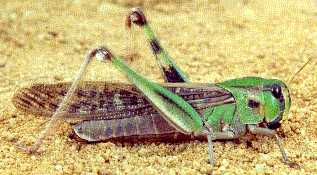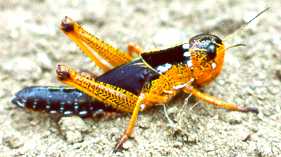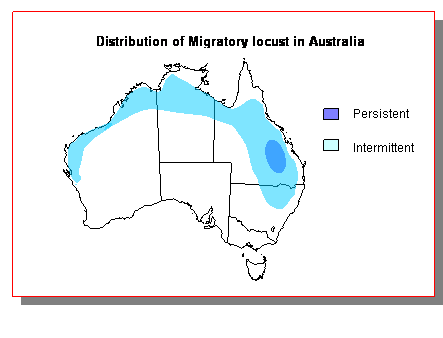The migratory locust, Locusta migratoria, is mainly a pest in the Central Highlands of Queensland where small outbreaks are frequent. Outbreaks also occur in the western Darling Downs and Roma and St George areas in southern Queensland. Migratory locusts are primarily grass feeders, attacking pastures and crops such as sugarcane, sorghum, wheat, barley, oats and maize.
[expand all]
Description
The migratory locust is a large, heavily built species of more 'blocky' appearance than the Australian plague locust or spur-throated locust.
It lacks the spur on the underside of the throat found in the latter species. Unlike the Australian plague locust the hind wings have no markings but may be faintly greenish-yellow in colour.

Adult - solitary form

Nymph - gregarious form
Body colouration varies according to population density from green to brown in the solitary form and straw in the gregarious form. The underside of the thorax is hairy. Adult males are 45-55 mm long and females are 55-65 mm long.
More images of this species can be found in the APLC Locust and grasshopper identification guide.
Biology and behaviour
Oviposition and egg development
The migratory locust often matures and lays eggs after rain, but will lay after several weeks even when the vegetation is drying off. Unlike the Australian plague locust, eggs of the migratory locust survive for only a short period in dry conditions. In central Queensland, the area most commonly infested with migratory locusts, winter temperatures are too high for eggs to enter a diapause stage, and diapause potential has not been demonstrated in Australia. Consequently, if the soil becomes dry after laying, survival of the eggs is poor and substantial mortality occurs unless rain falls at regular intervals throughout the year.
Like the Australian plague locust, the migratory locust lays its eggs in dense egg beds. Favoured egg laying sites include moist soil in areas of cultivation, silt beds resulting from erosion, creek beds or sorghum crops in silted areas.
Each egg pod contains 50 to 60 eggs and a single female may lay 3 to 5 egg pods during her lifetime. The eggs take about 11-15 days to develop depending on temperature.
Nymphs
At normal temperatures nymphs develop in about 30 days and undergo 5-6 moults before the adult stage is reached. However, in dry and cold weather development can take considerably longer.
When nymphs are present in large numbers they become highly gregarious and aggregate into dense, compact bands (up to 1500/m2) and display a characteristic marching movement. Bands can travel up to 500 m/day, depending on vegetation conditions.
Adults
Under normal summer temperatures adult migratory locusts live for about two months. They become sexually mature in about 14 days following fledging and at high densities usually form dense swarms.
Females are capable of laying an egg pod every 4 to 6 days. This species can develop rapidly when conditions are favourable and five to six generations are be possible in a year. Often these generations overlap and all stages of locusts may be present within a given area.
Migration
The migratory locust can migrate long distances but tends to do so less often than the Australian plague locust. Swarms in the Central Highlands of Queensland have at times moved as far westwards as Blackall, Barcaldine and Longreach, approximately 400 km away.
Distribution
The migratory locust occurs in Africa, eastern Europe and Asia and it is a major pest of agriculture in many countries. The subspecies in Australia, Locusta migratoria migratorioides, is also found in Indonesia, East Timor and Papua New Guinea. Swarming populations of migratory locusts are mainly restricted to central Queensland, shown as persistent distribution in the map below, but intermittent populations may extend across parts of northern Australia and into northern New South Wales. Low density populations of this species are common in coastal or subcoastal areas of Queensland and northern New South Wales.

